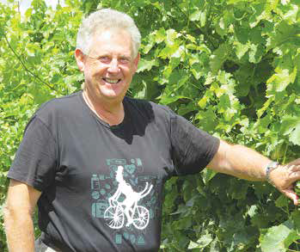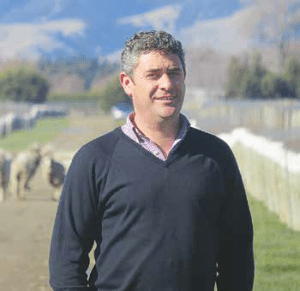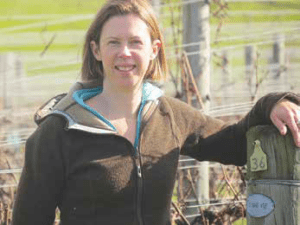Ask those working in the wine business if great wine is made in the vineyard and you’re likely to hear general agreement. So perhaps it’s not surprising that a New Zealand R&D programme to develop and market premium, lower alcohol wines has chosen to focus on natural production using sustainable viticultural techniques.
Lighter Wines Programme Manager David Jordan says research into site selection, canopy trimming and harvest timing is resulting in better grapes at lower brix, enabling naturally lighter wines with typical characteristics. These natural techniques also provide industry partners in the programme with a point of difference to many of the lower alcohol offerings in the market.
“We know demand for wines under 10% alcohol by volume is steadily climbing, and we know that consumers want those wines to be naturally lighter, making vineyards a key part of our research.” Lighter Wines, formerly called Lifestyle Wines, is a seven-year research and development programme led by New Zealand Winegrowers and co-funded under the Ministry for Primary Industries’ Primary Growth Partnership (PGP).
The 18 participating companies have invested significant time and money into applied research that includes winery processes, sensory evaluations and market research, as well as a raft of vineyard trials.
The vineyard work involves looking at old data with new eyes, as participants and researchers revisit information from previous vintages, to see which blocks and management techniques work
best, says Jordan. Rootstock, clone selection and a study on the variability of ripening between bunches early in the ripening phase are also within the programme’s scope, as researchers look at ways and means of naturally producing good wines at lower sugar levels, without too much acid.
New Zealand has a competitive advantage on that front, because its standard wines have an abundance of flavour, so still have oomph when picked early, Jordan says. “Those in Australia and elsewhere would struggle to replicate what we do.”
But the major advantage right now is the powerful “co-innovation” that’s amplifying ideas and findings, he says. “We are very fortunate with the technical expertise in our industry. You put a challenge or project of this type in front of them and the ideas and opportunities that come from the collective wisdom is powerful.” This combined with the openness to discuss these ideas with their peers amplifies the speed of progress even further.
Taking a leaf from Forrest’s book
 “I want to make you a lighter alcohol Marlborough Sauvignon Blanc or Rosé or Pinot Noir that ticks the boxes in terms of being typical,” says John Forrest, who has spent more than a decade developing his Doctors’ range (Forrest Estate’s lower alcohol range of wine) to do just that.
“I want to make you a lighter alcohol Marlborough Sauvignon Blanc or Rosé or Pinot Noir that ticks the boxes in terms of being typical,” says John Forrest, who has spent more than a decade developing his Doctors’ range (Forrest Estate’s lower alcohol range of wine) to do just that.
On a South Island sales trip in 2006, Forrest saw “unanticipated” interest in the 8.5% alcohol content of his first ever Doctors’ Riesling. He returned to Marlborough determined to create a lighter alcohol Sauvignon with all the texture, flavour and balance people expect from the region.
Work began in the winery, chemically removing alcohol to produce wine that retained some flavour, but was thin with an unsatisfying mouth feel. After two years, Forrest transferred his attention to the vines, where his first frustrating forays surrounded picking fruit at 17 brix. “The only lesson was that you made pretty poor to average unripe flavoured wine out of unripe Sauvignon,” Forrest says.
“It forced me to think outside the square and really ask that key question – ‘from veraison to harvest, what is the plant doing?’ And the answer is, ‘It’s making sugar, it’s making flavour, it’s dropping acid and its getting phenolic ripeness,’ which means the skin and the pips are becoming not as bitter and not as drying and more acceptable for wine-making,” he says. “Those are the key parameters in the 60 days from February to April.”
After seven years of trials by his vineyard and winery team, and a Government grant that allowed Forrest to engage Plant and Food Research scientist Mike Trought to assess the vines’ physiology, Forrest found a way to slow the accumulation of sugar in the vines by trimming what he calls “alpha” leaves.
Left with the less productive young and old leaves (akin to babies and oldies in human terms) but not the hard working alphas, the vine has less ability to accumulate sugar quickly. That allows a longer hang time so that the vines are exposed to the 20degC diurnal fluctuations later in the season, which play such an important role in the success of Marlborough’s wine.
Forrest warns that while the trimming work is replicable, growers cannot go in and “blindly pluck”. Each vintage the climate conditions, the health of the vines and the physiological status of the leaf is variable, and management needs to adapt accordingly. “I have learned the hard way that there are variations you have to consider, depending on the vintage. You have to be right on top of what the vintage is doing to you and the climatic prediction for the 60 days from veraison to harvest.”
By 2013, Forrest was at the point where his lighter alcohol wines met both his quality parameters and the cost restraints of the market. “Suddenly we had a commercial product to fill the growing demand.”
These days, half Forrest Estate’s wine is lighter alcohol, with nearly 50,000 cases of the Doctor’s wines – a Pinot Noir (their first release is soon to hit the market), Sauvignon Blanc, Pinot Rosé and Riesling at between 9% and 9.5% ABV – going to premier supermarkets around the world each year, with that number growing fast.
It’s finding success beyond the shelves, with the Doctors’ Rosé taking gold and the Sauvignon Blanc silver at the recent International Melbourne Wine Competition, and the Doctors’ Riesling and Rosé both winning gold and trophy in this year’s New World Wine Awards. “So the low alcohols are performing well,” says Forrest.
After 10 years “thinking, living, breathing and drinking” lower alcohol wine development, Forrest shared all his research findings with the Lighter Wines project, seeing enormous potential for New Zealand’s wine industry to be the world-leading name in naturally produced premium lower alcohol wine. “Low alcohol opens up a whole new segment of the world wine market and it’s not competing with conventional or higher alcohol. That’s really exciting for New Zealand.”
The right place and the light wine
 For many of the companies in the Lighter Wines Programme, looking back has been the best way to move forward.
For many of the companies in the Lighter Wines Programme, looking back has been the best way to move forward.
Giesen Wines Senior Viticulturist Mike Poff says the company used data from multiple seasons to choose the best sites for its lower alcohol wines, focussing its attention on the Lower Wairau, where grapes have historically reached physiological ripeness with lower sugar accumulation, allowing for earlier picking. “We sat and thought about what’s ripe but with low brix. With 60% of our fruit coming from the Lower Wairau, it was a logical choice.”
Speaking from the Bay Block vineyard on Dillons Point Rd, with deep silty loam underfoot, he says others in the programme were looking at sites that were stony and free draining, expecting to get riper characters earlier. “But we get that here naturally. This is some of the first fruit we pick, and in the past we have picked anywhere from 19.5 to 20.5 brix here. That’s pretty normal.”
With site selection in the bag, the company focussed on certain blocks for the lower alcohol wines, picking at around 18 or 19 brix in 2015, resulting in wine with higher residual sugar and
10% alcohol.
In 2016, they did some work in the winery to dealcoholize the wine and in early 2017 kicked off a canopy trial, taking about 50cm from the top of vines in a 2ha block, using a barrel pruner. The
trimming was done around veraison and the impact was exactly as they intended, slowing down the development of the vines, says Poff. “We saw acidity drop and brix took a lot longer to climb, with slower sugar accumulation.”
However, it was a case of ‘be careful what you wish for’, with the inclement and windy 2017 season ultimately resulting in poor ripening across the province, giving the already impeded lower alcohol vines an unexpected double whammy. “It wasn’t the perfect scenario, and not a true representation of the trial,” he says.
Giesen will continue its vineyard and winery trials into 2018, with the lower alcohol wine work influencing the entire range, says Poff. “For us one of the benefits coming out of the programme is
how it’s going to reduce alcohol across all of our wines. We have started to pick a lot of our premium Pinot Noir and Chardonnay earlier, migrating the alcohol from 14.5% to 13%.”
That is not driven by market demand for lighter wines, but rather a focus on brightness of fruit and ripeness of phenolic content, “to get the fruit really in balance”, says Poff.
Beyond Lighter Wines
 There are plenty of challenges to tackle through the Lighter Wines Programme, with site selection, vintage variation, acid levels and texture, to name a few. But Villa Maria’s Senior Marlborough Winemaker Helen Morrison says the research is bearing fruit, and has benefits beyond the lower alcohol wine category.
There are plenty of challenges to tackle through the Lighter Wines Programme, with site selection, vintage variation, acid levels and texture, to name a few. But Villa Maria’s Senior Marlborough Winemaker Helen Morrison says the research is bearing fruit, and has benefits beyond the lower alcohol wine category.
“What I think will be interesting is not just for the wine companies making lower alcohol wines, but actually how can we be using all this science for New Zealand collectively, to give a point of difference?”
With a lot of high alcohol wine coming out of Australia and California, Morrison sees opportunity to apply Lighter Wines learnings across the board, “getting all the full flavour and texture and palate weight into wine that may have 1% or 0.5% less alcohol, so you get a competitive advantage.”
Villa has a Pinot Gris and Sauvignon Blanc in the Private Bin Lighter Wines range, as well as a Rosé that’s shown the most success in the market and won the FoodHQ Beverages Award at the
2016 New Zealand Food Awards. The company began its lower alcohol work with informed guesswork about what would work where, leading to a focus on Rosé in Hawke’s Bay, and Sauvignon Blanc and Pinot Gris in Marlborough.
However, the acidity of Marlborough Pinot Gris grapes at lower brix made that option untenable, and the focus has moved to the North Island, where Villa Maria achieves lower sugar with lower acidity, allowing for a more balanced lighter Pinot Gris. Morrison was not surprised to have such assumptions turned on their head, having worked at Forrest Estate in 2006, when the company released its Doctors’ Riesling, and in 2009, when the Doctors’ Sauvignon Blanc followed suit.
At that time the sites they “instinctively” thought would be best were often found to be unsuitable, she says. “I had that inkling that what in your head you think will be the right site doesn’t necessarily pan out that way.”
Following the initial learning with Pinot Gris, Villa Maria targeted a handful of sites in Marlborough’s Wairau and Awatere Valleys, to see how each would perform with Sauvignon Blanc. They started out with a stony, hot site off Old Renwick Rd, which was typically harvested at lower brix, to keep it fresh. It held promise for lower alcohol wines, but while sugar and acidity were great, “the flavour wasn’t there”.
Another site up the Brancott Valley, with deeper clay soil, reaped much better results, because the part of the vineyard selected for lower alcohol wines was exposed to wind, and vines struggled through the season in a typical year, slowing sugar accumulation.
The site worked well for a few years, with the right acidity numbers and a good ripe flavour profile at 18 brix, she says. “But the ironic thing is that it is a grower block and he likes to work really hard in his vineyard, so has done a lot of composting work to get it healthy.” Now she’s seeing lush green canopies and little hope for a lower alcohol wine without canopy manipulation.
Meanwhile, there has been a lot of focus on the company’s Taylor Pass Vineyard, which is where Villa has conducted most of its lighter wine trials. Here clone selection was part of the package when assessing the site’s suitability, with the Bordeaux clone Sauvignon Blanc generally displaying lower acidity levels, says Morrison. However, they soon discovered that the acidity drops “quite dramatically” at around 21 brix, too late for lighter wine harvest.
Morrison says Sauvignon has definitely been the most difficult variety when it comes to delivering a lighter alcohol wine that looks like its standard counterpart, “because that acidity level is
so challenging at the lower sugar levels”. But continued research, including that being “fine-tuned” though the PGP research programme, shows that knocking the canopy back halfway through
veraison, thereby extending the hang time, is helping she says.
Meanwhile, Villa Maria ensures it gives its winemakers plenty of options when it comes to making the wine, supplying four times the amount of fruit required, says Morrison. “That is due to the luxury of Sir George’s commitment to innovation.”
















